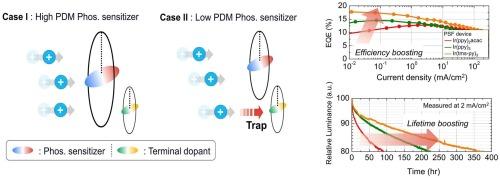高永久偶极矩敏化剂是高效磷敏化荧光系统中末端掺杂反电荷捕获的关键
IF 22
1区 材料科学
Q1 MATERIALS SCIENCE, MULTIDISCIPLINARY
引用次数: 0
摘要
为了设计一个高效的磷敏化荧光(PSF)系统,抑制终端掺杂中空穴陷阱的形成是至关重要的。然而,抑制终端掺杂中空穴陷阱形成的策略尚未得到充分探索。在这项研究中,我们提出了一种通过使用高永久偶极矩(PDM)磷光敏化剂解决终端掺杂中的电荷捕获问题来提高PSF器件整体性能的方法。通过高PDM和捕获能量的级联调制,终端掺杂中被捕获的电荷被明显抑制。高PDM和浅最高已占据分子轨道(HOMO)能级的磷光敏化剂表现出最高的陷阱抑制能力。与纯tbrb器件相比,增强的陷阱抑制能力使外部量子效率提高了391%,器件寿命延长了三倍。最后,我们提出了一种基于PDM和陷阱能级的阻抗谱综合影响来选择具有高陷阱抑制能力的磷光敏化剂的指导原则。这个框架为开发先进的PSF系统提供了有价值的见解。本文章由计算机程序翻译,如有差异,请以英文原文为准。

High-permanent dipole moment sensitizers as key to anticharge trapping of terminal dopant in highly efficient phosphor-sensitized fluorescence systems
To design a highly efficient phosphor-sensitized fluorescence (PSF) system, it is crucial to suppress hole trap formation in the terminal dopant. However, strategies to suppress hole trap formation in terminal dopants have not been fully explored. In this study, we propose an approach to improve the overall performance of PSF devices by addressing charge trapping in the terminal dopant using high-permanent dipole moment (PDM) phosphorescent sensitizers. Through the cascade modulation of high PDM and trap energy, the trapped charges in the terminal dopant were significantly suppressed. The phosphorescent sensitizer with high PDM and shallow highest occupied molecular orbital (HOMO) energy levels exhibited the highest trap suppression capability. The enhanced trap suppression capability resulted in a 391% improvement in the external quantum efficiency and a threefold increase in the device lifetime compared to a TBRB-only device. Finally, we present a guideline for selecting phosphorescent sensitizers with high trap suppression capability based on the combined influence of PDM and trap energy levels via impedance spectroscopy. This framework provides valuable insights into the development of advanced PSF systems.
求助全文
通过发布文献求助,成功后即可免费获取论文全文。
去求助
来源期刊

Materials Today
工程技术-材料科学:综合
CiteScore
36.30
自引率
1.20%
发文量
237
审稿时长
23 days
期刊介绍:
Materials Today is the leading journal in the Materials Today family, focusing on the latest and most impactful work in the materials science community. With a reputation for excellence in news and reviews, the journal has now expanded its coverage to include original research and aims to be at the forefront of the field.
We welcome comprehensive articles, short communications, and review articles from established leaders in the rapidly evolving fields of materials science and related disciplines. We strive to provide authors with rigorous peer review, fast publication, and maximum exposure for their work. While we only accept the most significant manuscripts, our speedy evaluation process ensures that there are no unnecessary publication delays.
 求助内容:
求助内容: 应助结果提醒方式:
应助结果提醒方式:


